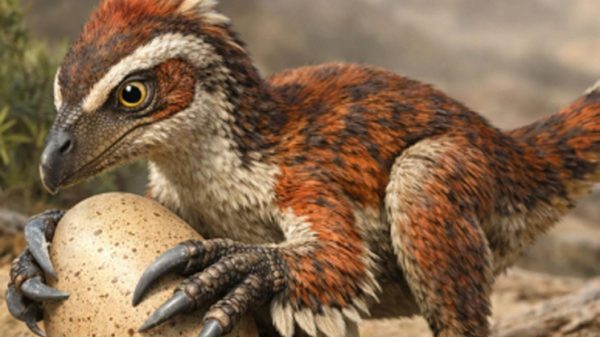“The forest was rebuilt in such a way that the composition of plants changed”
New research shows that modern grapes appeared because dinosaurs became extinct. Grapes have been linked to human history for thousands of years, providing the basis for the wines made by our ancestors thousands of years ago, but according to new research, this might not have been the case if dinosaurs had not disappeared from the face of the earth.
 Photo: unsplash.com
Photo: unsplash.com
When an asteroid hit the Earth 66 million years ago, it wiped out massive, lumbering animals and paved the way for other creatures and plants to flourish, CNN says.
Now the discovery of fossilized grape seeds in Colombia, Panama and Peru, ranging in age from 19 to 60 million years, is shedding light on how these humble fruits gained a foothold in the Earth's dense forests and eventually spread throughout the world. One of the newly discovered seeds is the oldest member of the grape family of plants native to the Western Hemisphere, according to a study published Monday in the journal Nature Plants.
“These are the oldest grapes ever found in this part of the world, and they are several million years younger than the oldest varieties ever found on the other side of the planet,” said lead study author Fabiani Herrera, assistant curator of paleobotany at Field Museum at Chicago's Negaunee Center for Integrative Studies. “This discovery is important because it shows that after the extinction of the dinosaurs, grapes actually began to spread throughout the world.
Like animal soft tissue, true fruits are poorly preserved in fossils. But the seeds, which are more likely to become fossils, can help scientists understand which plants were present at different stages of Earth's history as they reconstruct the tree of life and establish origin stories.
The oldest grape seed fossils found on today, were discovered in India and date back to 66 million years ago, around the time of the extinction of the dinosaurs.
“We always think about animals, about dinosaurs, because they suffered the most, but the extinction also had a huge impact on plants,” says Fabiani Herrera. – The forest has rebuilt itself in a way that has changed the composition of the plants.» Herrera's supervisor, Stephen Manchester, who is also the senior author of the new study, published a paper about grape fossils found in India. This inspired Herrera to wonder where other grape seed fossils might exist, such as in South America, although they had never been found there.
«Grapes have a history of about 50 million years, so I wanted to find them in South America, but it was like looking for a needle in a haystack,» Herrera says. «I've been looking for the oldest grape variety in the Western Hemisphere since my undergrad.»
Herrera and study co-author Mónica Carvalho, assistant curator at the University of Michigan Museum of Paleontology, were conducting field research in the Colombian Andes in 2022 when Carvalho discovered the fossil. It turned out to be a 60-million-year-old fossilized grape seed encased in rock, one of the oldest in the world and the first to be found in South America.
“She looked at me and said, "Fabiani grapes !’ And then I look at it and think, «Oh my God.» It was so exciting,” says Herrera.
Even though the fossil was tiny, its shape, size and other features helped scientists identify it as a grape seed. Back in the lab, the researchers performed CT scans to examine the internal structure and confirm their findings.
They named the newly discovered species Lithouva susmanii, or «Susman's stone grape,» after Arthur T. Susman, who was proponent of South American paleobotany at the Field Museum.
«This new species is also important because it confirms the South American origin of the group in which the common grape evolved,» said study co-author Gregory Stull of the National Museum of Natural History.
The stones were deposited, Herrera said. in ancient lakes, rivers and coastal areas.
“To find these tiny seeds, I chip away at every piece of rock I have in the field,” Herrera says, adding that the difficult search “is the most interesting part.” part of my work as a paleobotanist.»
Encouraged by their discovery, the team conducted additional fieldwork throughout South and Central America and discovered nine new species of fossil grape seeds embedded in sedimentary rocks. By tracing the origins of the ancient seeds to their modern counterparts, the team realized that something allowed these plants to thrive and spread.
The team theorized that when the dinosaurs went extinct, their absence changed the entire structure of the forests.
< p>“Large animals such as dinosaurs are known to change the ecosystem around them. We think that if large dinosaurs once roamed the forest, they most likely felled trees, effectively keeping the forests more open than they are today,” says Monica Carvalho.
After the extinction of the dinosaurs, tropical the forests grew greatly, and layers of trees formed the undergrowth and canopy. These dense forests made it difficult for plants to access light, and they had to compete with each other for resources. According to the researchers, climbing plants had an advantage and used it to reach the tree canopy.
“In the fossil record, we start to see more plants that use vines to climb trees, like grapes, around this time,” Herrera says.
Meanwhile, as the dinosaurs disappeared, the Earth began to be populated a variety of birds and mammals, they probably also contributed to the spread of grape seeds.
The study of the seeds tells the story of how grapes spread, adapted and went extinct over thousands of years, demonstrating their resilience to survive in other parts of the world despite eventually disappearing from Central and South America.
Several fossils are associated with modern grapes, while others are distant relatives or native to the Western Hemisphere. For example, some of the fossil species can be attributed to grapes, which today are found only in Asia and Africa, but it is unclear why grapes became extinct in Central and South America, Herrera says.
“The new fossil species tell us a turbulent and complex history,” he said. — We usually think of diverse and modern rainforests as «museum-like.» models where all species accumulate over time. However, our study shows that extinction was a major driver in the evolution of tropical forests. Now we need to determine what caused these extinctions over the past 60 million years.
Herrera wants to look for other fossil plant specimens, such as sunflowers, orchids and pineapples, to see if they existed in ancient rainforests .
Studying the origins and adaptations of plants in the past helps scientists understand how they can survive the climate crisis.
“I just hope that most living plant seeds quickly adapt to the present climate crisis. Fossil remains of seeds tell us that plants are resilient, but can also completely disappear from an entire continent,” Herrera states.





















































Свежие комментарии